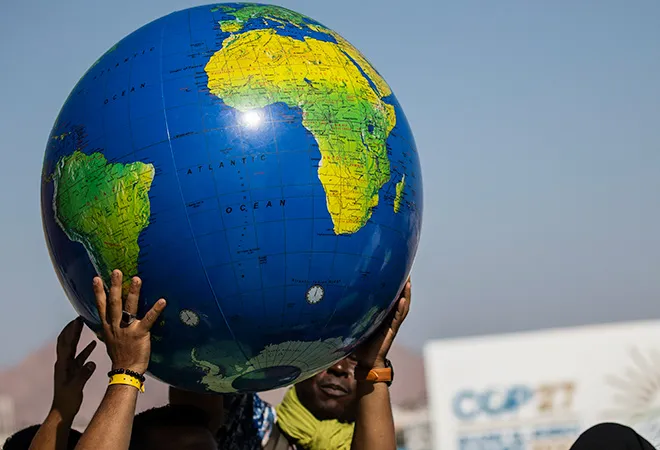
This piece is part of the series, Common But Differentiated Responsibility: Finding Direction In COP27
There is “no credible pathway to 1.5°C in place”, stated the UN Environmental Protection Agency on October 27, 2022. A couple of weeks ahead of this year’s global climate conference, COP27, the message couldn’t be clearer: Stop the pledges and start the action.
Just scrolling through headline after headline on UN news will surely put anyone in a gloomy mood: The climate crisis is hitting everyone; harder and faster than many are prepared for. But how come that we, as a global population, have missed so many thresholds?
“The answer is complex…” would be a well-known, often repeated cop-out. And sure, it is. But it also boils down to one thing: Diffused responsibility. A lot of this diffusion is the result of climate misinformation. Namely, narratives and messaging that redirects attention or blame by versions of “What about-ism?”. In other words, the complexity of the challenge is used to point fingers at another piece of the puzzle before assuming responsibility for one’s own contribution—a phenomenon more actors are culpable of than one would hope, and maybe even expect.
In the past, climate misinformation often came in the form of outright climate change denial. Over time, this has shifted towards various delay tactics, such as “climate action is a threat to our economy or national security”, “a warmer climate means longer farming/agricultural periods”, “renewable energy is insufficient or unreliable” etc. If this was it, if there were no other forms of climate misinformation, we would probably be further along in the necessary transition towards a net-zero emissions society.
The complexity of the challenge is used to point fingers at another piece of the puzzle before assuming responsibility for one’s own contribution—a phenomenon more actors are culpable of than one would hope, and maybe even expect.
However, there is more to the delay of necessary reduction and mitigation efforts than the above. The sense of diffuse responsibility is propagated at least across four levels:
- Direct attention towards individual, rather than corporate responsibilitiesThe unsurprising culprit, the fossil fuel industry, has spent decades on directing attention towards individual responsibility. These efforts have been so terrifyingly successful that you’ll have people tell you that they feel out of place at a climate strike because they aren’t able to buy the latest, most sustainable sneaker. Individual guilt is powerful—and utterly misplaced in the face of such an enormous, systemic challenge as the climate emergency. Now, the sustainable choice is often a privileged, expensive choice. Slow fashion, locally grown, organic food, heat pumps, or even taking the train instead of flying—all these choices come with a price tag. Our systems—and supply chains—are so closely entangled with the extraction and usage of fossil fuels that sustainable products, like fashion made from natural fabrics and on demand or agricultural products grown in rotation and without chemical fertilisers, can barely compete with globalised, mass supply chains that cater to abundance instead of need. The sustainable choice must be the easy choice. Making that happen requires mindset shifts, but first and foremost it is a corporate responsibility as it requires an end of fossil fuel extraction and a transition towards renewables and local supply chains.
- Distract with marketing messages of tech solutionsTechnology and digital tools are referenced in almost all climate reporting. As vague as the umbrella term may seem sometimes, there is a very clear sentiment that we need technological solutions to tackle the climate crisis— digitising industrial processes to increase efficiency, digital twins for planning and analyses, smart grids to manage electricity demand and supply. The list goes on. However, this pivot towards “the solution to the climate crisis is technology” has on the one hand, slowed continuous expansion of non-technical reduction efforts, like expanding bike and pedestrian infrastructures in urban centres, dietary education or reviewing the effects of governmental subsidies. On the other hand, this pivot has placed even more power into the hands of Big Tech, whose reach and influence allows them to shape discourse and perception. Many of the tech giants build components and software powering the digital processes of necessary engineering solutions, be it for modelling urban planning, providing cloud infrastructure or developing data analytics for process optimisation. This work is important. But here is the crux: Their marketing pitches and corporate responsibility pledges aim to reassure that these companies assume responsibility and will fuel the digital transformation in a climate neutral, carbon negative, net zero way. Unfortunately, this too is misleading. To date, none of the top tech corporations have reduced their absolute emissions – a prerequisite to be a responsible, net-positive agent of change.
- Feed outrage instead of perspectiveIn its ideal form, the media functions as a corrective, a beacon to shed light on misbehaviours and transgressions. Yet, some parts of the media still publish pieces about extreme weather events, the energy or food crises without mentioning the climate crisis even with a half sentence. Worse: we’ve seen established media lean into the outrage over climate activism singling out and attacking individuals, instead of highlighting delayed implementation of climate action, the lack of enforcement of governmental climate policies, or the fact that internationally agreed climate funds to support developing nations have yet to materialise. There has been a host of examples recently, with activists moving from protests and advocacy campaigns to more headline grabbing action, which includes things like gluing themselves to streets to disrupt traffic or throwing tomato soup at valuable paintings (protected by glass). Their actions are radical and meant to break through the climate lethargy that governments and societies seem to be caught in. Regardless of how one may feel about acts of civil disobedience, they are drawing attention to a global crisis that has been worsened due to delay and diffuse tactics. Consciously not linking out to pieces that call for punishment of “climate extremists”, blame protesters instead of traffic for accidents caused by cars, or casually drop threats of death sentences, it is important to stress that the media must not spread misleading and harmful narratives. With the power to inform the public comes responsibility and that requires context to be provided.
- Diffuse necessary decisions over short-term political prioritiesSadly, governments continue to slide back into short-term election cycles and a finger pointing game of who should move first. While on paper, all UN member states are committed to keep global warming well below 2°C and closer to 1.5°C, concerted action is lacking, and national implementation unfit for purpose. National commitments to reduce and mitigate climate impacts are way off the mark, with a catastrophic pathway of 2.8°C warming projected at the current rate. Yet, one might hope that the current—urgent—economic, political, social, and environmental pressures will force a shift in what makes a short-term priority and open a path to genuine conversation about collaboration and a meaningful recognition of loss and damages. Necessary investments and financial contributions are long overdue. And, at least in Europe, the invasion of Ukraine and the covid pandemic highlighted that money can and will be found; all we need is the political will to follow through.
In short, climate misinformation in its diffuse, distract and delay form is widespread and pervasive. Science tells us, we need to transform our societies. This transformation necessarily challenges anyone and anything that benefits or is comfortable within today’s system. Change will happen in our minds, in the stories we tell, the narratives we amplify, which is why it is so important to call out climate misinformation when we see it.
With increasing awareness, people are educating themselves, their families, friends, and communities, jointly processing the harsh reality of the climate crisis.
If in all this, you wonder: How are we going to turn things around?
Here is what gives us hope: Despite delay, distract and diffuse tactics, awareness of the climate crisis and the impact it has on many of our other crises—energy, food, violence, war, inflation, extreme weather events—keeps growing. With increasing awareness, people are educating themselves, their families, friends, and communities, jointly processing the harsh reality of the climate crisis. Conversations may not always be smooth, still, climate misinformation gets tackled at the kitchen table, on the streets, in watercooler conversations, and decision-making rooms. Bit by bit, this increases the willingness to reassess lifestyles, to demand alternatives, to question the credibility of pledges. Research shows that it takes as little as 3.5 percent of sustained public support for political movements to create systems change. While it may be fuzzy and hard to assess at a global scale, population polls in the EU, the US, and Africa all indicate growing support for decisive climate action. The challenge of the climate movement is to translate global awareness into local and national systems to overhaul the most harmful policies and practices in each specific context. For some, that’s abolishing fossil fuel subsidies, for others, its agricultural policies or water conservation. Local leaders are already doing tremendous work to translate and relay climate impacts in each specific context and what may feel like a drip on hot stone in isolated instances, provides momentum for sustained public support across borders.
And let’s not forget, in July 2022, the UN General Assembly adopted a historic resolution, which declared access to a clean, healthy, and sustainable environment a universal human right.
The views expressed above belong to the author(s). ORF research and analyses now available on Telegram! Click here to access our curated content — blogs, longforms and interviews.




 PREV
PREV


